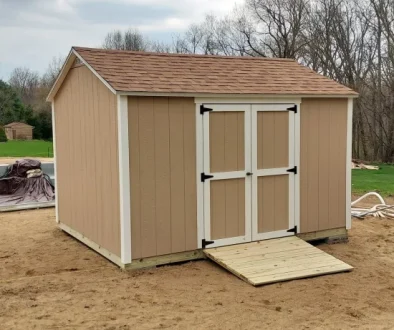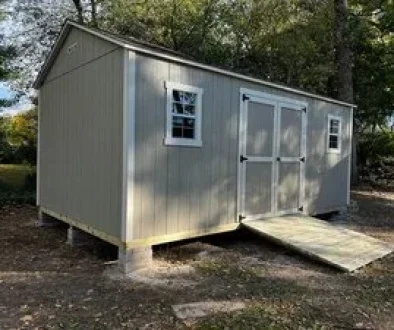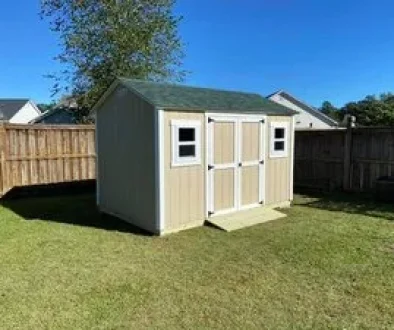How to Maintain and Weatherproof Your Shed for All Seasons
A custom-built shed is more than just a place to store your garden tools or holiday decorations—it’s an investment in your property. Whether you use it for storage, a workshop, or even a backyard retreat, your shed is constantly exposed to the elements. From scorching sun to heavy rain, high winds, and freezing snow, the changing seasons can take a serious toll on your structure if it’s not properly protected.
The good news? With the right maintenance plan and weatherproofing strategies, you can ensure your shed stays strong, functional, and great-looking all year round.
In this guide, we’ll walk you through how to maintain and weatherproof your shed for every season, ensuring it delivers the durability and performance you expect from a custom on-site build like those we offer at Effortless Shed.
1. Start With a Strong Foundation
Proper shed maintenance starts with what you can’t always see: the foundation. A shed that sits on poorly leveled or moisture-prone ground is vulnerable to warping, water seepage, and rot.
If you’ve had your shed built by Effortless Shed, you’re already ahead of the game. Our team levels and prepares the site with expert precision, reducing long-term risk. Still, it’s important to:
- Check the ground around your shed for standing water after heavy rain.
- Ensure the base hasn’t shifted or sunken due to soil erosion or freeze-thaw cycles.
- Keep grass, mulch, and soil pulled back from the base to prevent trapped moisture.
A well-maintained foundation protects your structure from the bottom up.
2. Inspect and Reseal Exterior Surfaces
Whether your shed is built with wood siding or engineered materials like LP SmartSide®, keeping the outer shell weather-resistant is essential. Sun exposure can cause fading, while moisture can lead to warping or mildew.
At least once a year, do the following:
- Visually inspect the exterior for any cracks, peeling paint, or gaps in siding or trim.
- Clean the walls with a mild detergent and soft brush to remove dirt, mold, or mildew.
- Repaint or re-stain exposed wood surfaces every 2–5 years depending on sun exposure and local climate. Use UV-resistant paint or weatherproof stain for added protection.
- Seal joints and corners with quality exterior caulk to block out wind and water.
Your shed’s exterior is its first line of defense—keeping it sealed and protected is critical.
3. Weatherproof the Roof
Your shed’s roof takes the brunt of seasonal wear. Whether it’s dealing with summer UV rays, heavy snow, or fall debris, roof maintenance plays a key role in weatherproofing.
Here’s how to stay ahead:
- Inspect shingles or metal panels for signs of lifting, cracking, or rust.
- Clear off leaves, pine needles, or snow that may cause moisture buildup.
- Check flashing and ridge caps to ensure they’re intact and securely fastened.
- In high-wind areas, reinforce your roof with hurricane clips or roof ties for added storm protection.
If you notice sagging, leakage, or dark stains inside the roofline, address them quickly—minor roof issues can escalate into major repairs fast.
4. Install Proper Ventilation
One of the most overlooked aspects of shed maintenance is airflow. Without proper ventilation, moisture gets trapped inside, creating an ideal environment for mold, mildew, and wood rot.
Here are a few ways to promote year-round ventilation:
- Add soffit vents or a ridge vent to allow hot air to escape naturally.
- Install a small window or louvered vent on opposing walls for cross-breeze ventilation.
- If your shed is insulated or used frequently, consider a solar-powered fan or low-voltage exhaust vent.
Adequate airflow not only prevents moisture damage—it also keeps your stored items dry and fresh through every season.
5. Protect Doors, Windows, and Hardware
Doors and windows are often the weak points in a shed’s weather defense. They need special attention during maintenance:
- Lubricate hinges and locks every 6 months to prevent rust and freezing.
- Check door alignment to ensure it opens and closes without sticking—misalignment can indicate foundation shifts or wood swelling.
- Seal window frames with fresh caulk and add weatherstripping to minimize air leaks.
- During winter, install storm covers or plastic film over windows to add insulation and reduce drafts.
A tight, well-sealed entryway ensures your shed remains secure and climate-resistant.
6. Seasonal Maintenance Checklist
To keep your shed in peak condition, create a seasonal maintenance plan. Here’s a basic breakdown:
Spring
- Clean gutters and roof of winter debris
- Check for water damage or rot
- Inspect paint and siding
Summer
- Reseal or repaint exterior surfaces
- Lubricate hardware
- Treat for pests (ants, termites, wasps)
Fall
- Remove leaves from roof and base
- Seal cracks and apply fresh caulk
- Prep for snow load if applicable
Winter
- Clear snow from roof regularly
- Check interior for condensation
- Monitor for ice dams or freeze damage
Final Thoughts
A shed isn’t just a structure—it’s a year-round solution that protects your tools, equipment, and even hobbies from the elements. By taking the time to properly maintain and weatherproof your shed, you’re preserving its performance, preventing costly damage, and maximizing the return on your investment.
At Effortless Shed, we build custom, on-site sheds that are made to last—and with a little seasonal care, yours will continue to serve you through rain, shine, wind, or snow.
Need help designing a weatherproof shed built for your region? Get a free estimate and let us build it right, right where it belongs.







